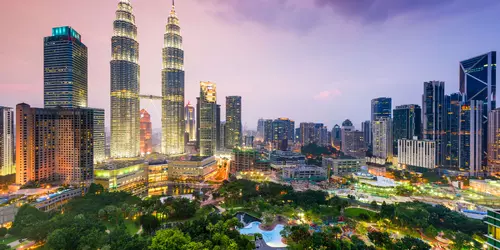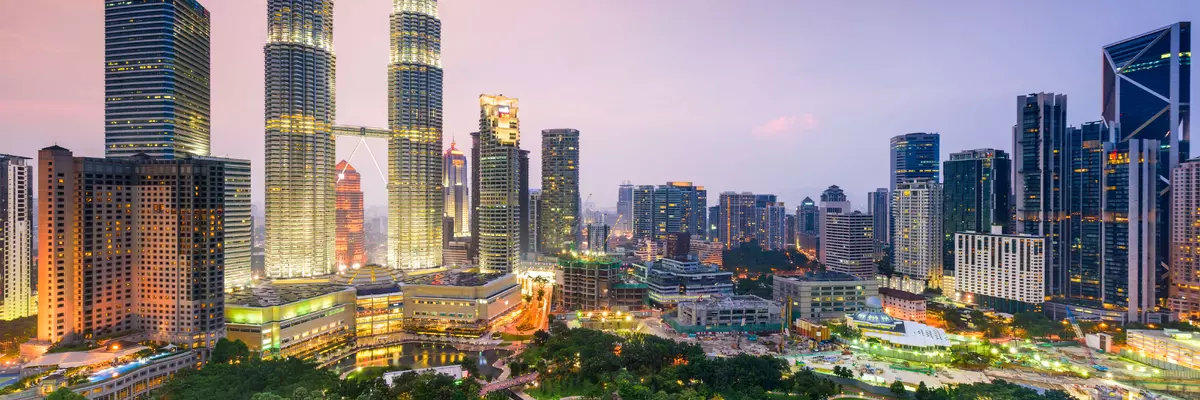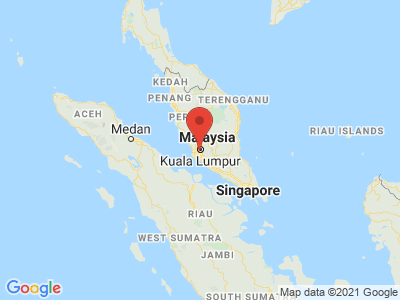Climate Table Kuala Lumpur
Jan | Feb | Mar | Apr | May | Jun | Jul | Aug | Sep | Oct | Nov | Dec | |
|---|---|---|---|---|---|---|---|---|---|---|---|---|
| Max. Temperature | 32° | 33° | 33° | 33° | 33° | 33° | 33° | 32° | 32° | 32° | 32° | 32° |
| Min. Temperature | 22° | 22° | 23° | 23° | 23° | 23° | 22° | 23° | 22° | 23° | 23° | 22° |
| Sun Hours | 6 | 7 | 7 | 6 | 6 | 7 | 7 | 6 | 6 | 5 | 5 | 5 |
| Water Temperature | 27° | 27° | 28° | 28° | 28° | 29° | 28° | 28° | 28° | 28° | 28° | 27° |
| Rain Days | 11 | 10 | 15 | 17 | 15 | 11 | 10 | 12 | 14 | 19 | 18 | 13 |
The climate year of Kuala Lumpur
Located just 35 kilometers off the west coast of Peninsular Malaysia, Kuala Lumpur is the capital of Malaysia and is home to about 1.5 million inhabitants. The name of the city means "muddy river mouth" and is due to the confluence of the two muddy rivers Gombak and Klang in the center of the city. Located directly in the valley of the Klang River, much of the city is only 27 meters above sea level. In addition, the city is surrounded by hills and mountains, which shield it from rain-bringing monsoon winds from the east and west. For this reason, Kuala Lumpur is on average somewhat drier than the countryside surrounding the city. Located only about 350 kilometers north of the equator, Kuala Lumpur is characterized by an equatorial climate with high temperatures throughout the year.
General information about Kuala Lumpur
.
Kuala Lumpur is a melting pot of cultures. Numerous ethnicities and religions find their space next to each other in the city. Thus, one finds Christian churches and mosques as well as pagodas and temples. During a tour of the city center, one can trace the relatively recent history of the city along the architectural buildings. It was not until the middle of the 19th century that the foundations of the city were laid in the middle of the jungle at the mouth of a river. Colonial and magnificent buildings tell of the city's boom under British rule. Numerous modern buildings such as the world-famous Petronas Towers or the Menara television tower give an impression of the modern Kuala Lumpur as a city on the upswing. In addition, numerous other sights such as the Lake Gardens, the Batu Caves or the lively Chinese quarter attract millions of tourists every year.
Tourism Kuala Lumpur
Kuala Lumpur has a warm equatorial climate influenced by the sea. Consequently, temperatures in the city are subject to only minor seasonal fluctuations. The daily maximum temperatures hardly differ in the course of the year. However, the hottest days can be expected from February to July due to an average of 7 hours of sunshine. The fewest hours of sunshine can be expected from October to December, when the sun shines for an average of about 5 hours. Even at night, temperatures never cool below 20 degrees. Since most public buildings are equipped with strong air conditioning systems, it is nevertheless advisable to prepare for somewhat cooler hours when traveling. Humidity is high throughout the year. However, unlike temperatures, rainfall can vary throughout the year. Although rainfall can be expected year-round, the number of rainy days accumulates twice a year from March to May and from September to November. During the rainy seasons, heavy thunderstorms are more frequent, especially in the late afternoon. The torrential rains sometimes flood the city's road system. The best time to travel to Kuala Lumpur is therefore in January and February. The weather is also favorable in the summer months from June to August. Sometimes, however, a haze of dust particles, which are blown over from nearby forest fires, can settle over the city at this time of year.


